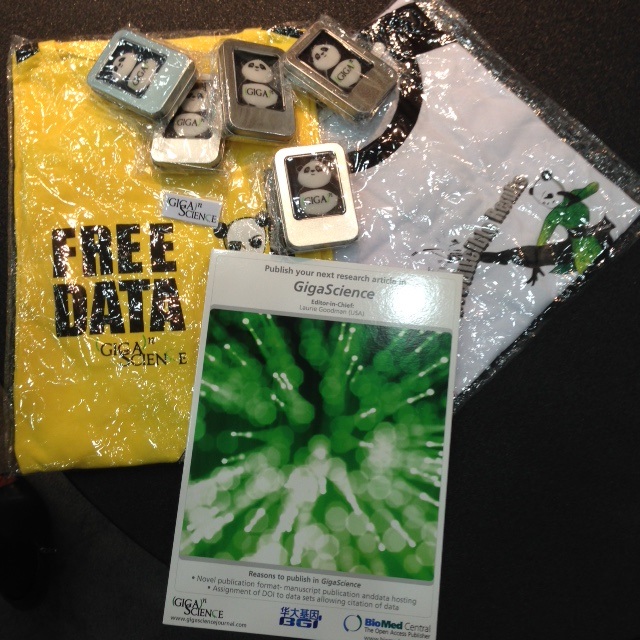
At BioMed Central we always look forward to attending the American Society of Human Genetics (ASHG) annual meeting. It’s the world’s largest genetics meeting, and now welcomes well over 6,000 delegates. This year in Baltimore ASHG certainly lived up to expectations by showcasing the hottest areas in human genetics.
In addition to some excellent science, delegates were graced with a delightful (apologies in advance to keen ornithologists out there if I’m incorrect) house sparrow that lived in the conference centre and flew playfully around in talks to the amusement of the crowd. You can follow him/her @ashg_bird.
Tweet tweet! #ASHG15
— ASHG Bird (@ashg_bird) October 8, 2015
Rewriting the genome
With gene editing being talked about anywhere and everywhere right now, it was unsurprising that this field was in the spotlight at ASHG 2015.
The prestigious Gruber Genetics Prize was awarded to Emmanuelle Charpentier (Helmholtz, Germany) and Jennifer Doudna (Berkeley, USA) for their involvement in the groundbreaking discovery and application of the CRISPR-Cas9 system. As many of you will know, this is a bacterial adaptive immune defence system that allows targeted homologous end joining to edit genes.
What makes CRISPR-Cas9 different to previous genome engineering techniques (such as zinc finger nucleases and TALENs) is that it involves RNA-DNA base pairing, allowing easy reprogramming and rapid targeting without the user having to engineer proteins. The unparalleled conformational change of Cas9 is responsible for the accuracy of this system.
It had been suggested by many that the Nobel Prize might go to CRISPR-Cas9 scientists this year, however it was recently awarded to William Campbell, Satoshi Omura and Youyou Tu for their incredible work in therapy against parasitic diseases. If CRISPR-Cas9 continues to have such an impact in biomedical science, and eventually reaches human therapy, it’s hard to imagine a Nobel Prize not being awarded to this area of research in the future.
In addition, there was a session dedicated to genome editing. Not only focusing on CRISPR-Cas9, the talks looked at other active areas of genome engineering, such as viral vector delivery, RNA interference, and stem-cell technology.
If you’re interested in this topic, Genome Biology will be publishing a special issue on Genome Editing in November 2015. Read the blog to find out more.
Opening up big data
ASHG did a great job of saving some of the best sessions to last. My personal favourite session was entitled “Opening up big data”. Several exciting projects were discussed, all involving new platforms designed for making better sense and use out of genomic data; an issue that is rapidly becoming more important.
Innovations included KLiKVAL, an open access tool for enriching scientific media through crowdsourcing, presented by Todd Taylor from Riken, Japan. Another was the Monarch Initiative (by Melissa Haendel, Oregon Health & Science University, USA), a “standard of standards” that collates model-organism phenotypic data, in the absence of there being a common language for phenotypes as there is for genomic sequences.
As with all big data, genomic data being open gives endless amazing opportunities. Having massive datasets of thousands of genomes allows us to infer causation/association with disease, make important links with lifestyle, and potentially personalise medical treatment. So there was a real push for open data here.
The hope is that commercial personal genomics companies will use their invaluable data for the greater good more often. This is already starting to happen – back in January 2015 it was announced that 23andMe will be sharing genomic data of 650,000 individuals with Pfizer to Study Parkinson’s disease. Sharing resources, the companies say, will help them figure out new ways to treat disease and to design clinical trials.
Although there are potential privacy issues here that may make some individuals feel uncomfortable, by trusting that anonymity remains, the benefits most definitely outweigh the possible costs. I, like many, hope this will be a continuing trend in genomics.

Our journal of data-intensive research and innovation, GigaScience, is a renowned advocate for open data. Feel free to let me know if you’d like any fierce FREE DATA GigaPanda items that we were handing out at the ASHG booth. You can also check out the GigaBlog’s ASHG15 blog for further insights into the meeting, written by Managing Editor Scott Edmunds (@SCEdmunds).
- Raising funds for genetic diseases - 23rd September 2016
- The Epigenetics and Chromatin Clinic - 9th November 2015
- Resurrecting one of the oldest genetics journals - 23rd October 2015
Comments